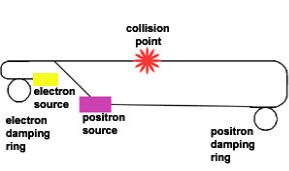
Handy Links
SLAC News Center
SLAC Today
- Subscribe
- Archives: Feb 2006-May 20, 2011
- Archives: May 23, 2011 and later
- Submit Feedback or Story Ideas
- About SLAC Today
SLAC News
Lab News
- Interactions
- Lightsources.org
- ILC NewsLine
- Int'l Science Grid This Week
- Fermilab Today
- Berkeley Lab News
- @brookhaven TODAY
- DOE Pulse
- CERN Courier
- DESY inForm
- US / LHC
SLAC Links
- Emergency
- Safety
- Policy Repository
- Site Entry Form

- Site Maps
- M & O Review
- Computing Status & Calendar
- SLAC Colloquium
- SLACspeak
- SLACspace
- SLAC Logo
- Café Menu
- Flea Market
- Web E-mail
- Marguerite Shuttle
- Discount Commuter Passes
-
Award Reporting Form
- SPIRES
- SciDoc
- Activity Groups
- Library
Stanford
Around the Bay
Designing a Particle Superhighway
 In the International Linear Collider (ILC), electrons and positrons will travel
in the fast lane, eventually smashing into each other with unprecedented energies.
Yet before the particles can begin their journey down the linear accelerator, they
need to make it to their respective starting lines, 30 kilometers apart. This task
is more difficult than one might
expect.
In the International Linear Collider (ILC), electrons and positrons will travel
in the fast lane, eventually smashing into each other with unprecedented energies.
Yet before the particles can begin their journey down the linear accelerator, they
need to make it to their respective starting lines, 30 kilometers apart. This task
is more difficult than one might
expect.
Due to technical constraints, both the electrons and positrons will be created on one end of the machine. The electrons will be fed into the nearby damping ring and then into the linac, but the newly created positrons must travel all the way down to the other end of the accelerator before turning around and accelerating back toward the collision point. Precisely guiding this beam over such a long distance is a challenge.
Until recently, the beamline bringing positrons to the starting line was little more than a conceptual abstraction. SLAC's Feng Zhou and a team of researchers including Mark Woodley, Yuri Batygin, Vinod Bharadwaj, Axel Brachmann, Yuri Nosochkov, and John Sheppard have spent the past three months planning how to get the positrons from where they are made to their own starting point at the other end of the collider.
"Designing the beamline requires tremendous attention to detail," says Zhou. "Each section should exactly match its neighbors to ensure that there are no holes or gaps."
In the beamline, thousands of carefully positioned magnets will keep the particles tightly bunched as they race towards their destiny. Additionally, the team has specified the type and location of diagnostic stations to measure the beam and bending magnets to connect from one section of the beamline to another.
The SLAC team has already completed a preliminary design for nearly 20 kilometers of beamline.
"We will keep optimizing the design until the lattice is constructed," Feng says.
—Chandra Shekhar
SLAC Today, June 12, 2006
Image: In the ILC, both electrons and positrons will be created on one side of the accelerator; the electrons will be directly injected into a damping ring, while the positrons will have to travel the length of the accelerator before being injected into their own damping ring.